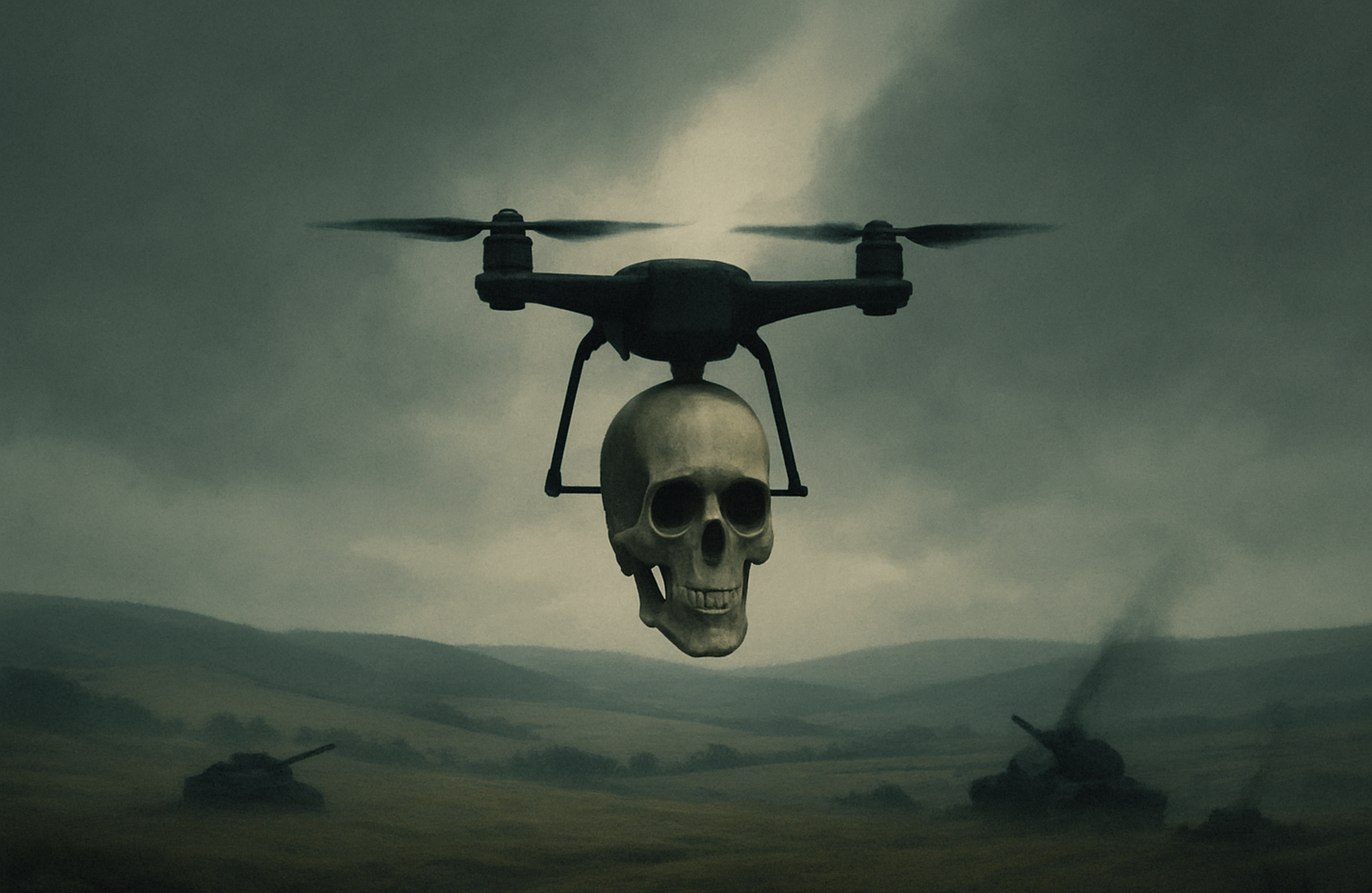Plastic Wings; Real War

Imagine if Ukraine, through the use of a highly advanced and undisclosed technology, managed to render every Russian tank unusable overnight. No explosions, no drone strikes, no smoking wrecks—just silent, intact machines rendered unusable, permanently inoperable and beyond repair. The machinery sits silent across the battlefields, in bases or in factories; engines unresponsive, systems dead. No damage visible to the eye, no evidence of violence—only sudden paralysis. What would happen next? Would this development force Russia to give up? Would the war end? Think about that for a moment.
Before offering an answer to this hypothetical question, I want to diverge for a moment and speak about something less hypothetical.
Drones in Conventional Warfare
The use of drones in warfare is far from a recent innovation. Even a country like Iran, under immense technological and economic constraints during the 1980s, managed to deploy its own Unmanned Aerial Vehicles. The Mohajer-1, first used in 1986 during the Iran-Iraq War, was a rudimentary platform by today’s standards—it carried analogue film cameras, required manual retrieval of footage, and had no real-time transmission capabilities. But its purpose was clear and proved to be of use to the Iranians during the war.
The existence and deployment of such a system decades ago makes it clear that drones are not a futuristic tool that suddenly appeared on modern battlefields—they are the product of long-standing military adaptation, often born out of necessity rather than luxury.
Also, the viability of FPV drone warfare today is not the direct result of top-down military innovation, but rather a byproduct of advancements in consumer technology. At the heart of this shift are components such as: high-discharge batteries that provide a favourable weight-to-power ratio, compact electric motors capable of precise adjustments, and small cameras that can stream real-time footage over considerable distances. Combined, these elements—alongside many other related technologies—enabled the rise of nimble, human-guided drones that can navigate complex environments and deliver small payloads with acceptable accuracy.
The transition from civilian to military application also required minimal modification—an explosive charge here, a detonation mechanism there—and suddenly, battlefield assets once reserved for well-funded state actors became accessible to anyone with basic technical knowledge, although with much more limited effectiveness and lethality.
One of the most important technical enablers of today’s FPV drone warfare is the evolution of live video feed technology. Whilst these systems are nowhere near as secure or robust as military-grade data links, their advancement—driven largely by consumer demand—has made real-time visual piloting widely accessible. This development fundamentally changed what was possible with small unmanned aircraft. Suddenly, a hobbyist’s fixed-wing model aeroplane or RC helicopter was no longer just a toy—it could be flown into hostile environments.
Initially, analogue video systems dominated the hobbyist scene as they were the only option available. These feeds, transmitted over common frequency bands, were fast and lightweight but suffered from poor resolution, interference, and complete lack of encryption—although security was not a concern, at least not in most civilian applications. Still, they offered one essential advantage: minimal delay. The low latency made it possible to guide RC aeroplanes in real time, dodging obstacles and having fun. The technology wasn’t elegant and far from perfect, but it worked.
In recent years, digital systems emerged to offer a higher-quality alternative. With crisper resolution, improved range, and the ability to include onboard recording of higher-quality videos than transmitted, these systems began to replace analogue setups in many use cases. Whilst they introduced some latency and complexity, they also brought a level of precision and fidelity previously unavailable in commercial analogue platforms. This combination of real-time vision and relative affordability made RC aeroplanes not just flyable, but even more useful for other applications such as in humanitarian efforts.
But the rise of quadcopters owes a great deal to progress in energy storage systems. Unlike fixed-wing RC aeroplanes that can rely on small combustion engines for propulsion, quadcopters—or similar designs such as hexacopters—demand precise, continuous control of multiple motors to maintain stability and manoeuvrability. Combustion engines, with their delayed throttle response and uneven power delivery, are simply not suited for such a task. A quadcopter cannot fly unless its motors can be adjusted rapidly and independently—something only electric motors can provide.
However, using electric motors introduces a new challenge: power supply. For a long time, battery technology simply couldn’t meet the energy demands of products like a typical small quadcopter. Early batteries were too heavy, too weak, or discharged too slowly to keep a multi-motor system aloft for more than a few minutes. It wasn’t until the development and refinement of lightweight, high-discharge battery systems that quadcopters, for example, became viable even for recreational use. These batteries struck the balance between weight, capacity, and power output, enabling small drones to fly for extended periods and whilst carrying a payload.
This breakthrough didn’t just make quadcopters possible; it made them practical. Once hobbyists had access to reliable, rechargeable power sources that could sustain flight long enough to perform meaningful tasks, the platform began to evolve rapidly. Everything from recreational photography to precision agriculture—and eventually, battlefield use—became thinkable. Without this progress in energy storage, the multi-rotor drone as we know it today would still be a theoretical curiosity rather than an operational tool.
Precision Without Power
The current wave of FPV and long-range kamikaze drones seen in conflicts like the Russo-Ukrainian war is often misunderstood as a sign of technological superiority or strategic rethinking . In reality, their use is largely a response to scarcity. Traditional weapon systems—such as artillery shells, guided missiles, and cruise munitions—remain the gold standard for battlefield impact, but they are expensive, slow to produce, and heavily consumed during prolonged conflicts. When those options run low, militaries turn to alternatives that are faster and cheaper to manufacture, even if they are less effective.
In this context, small drones are not replacing conventional firepower; they are plugging the holes left by logistical strain. These systems are attractive not because they outperform artillery or missiles in raw destructive capability, but because they are available. The components needed to assemble them—motors, batteries, lightweight frames, and basic explosive charges—can be sourced from commercial supply chains or improvised with minimal infrastructure. This makes them especially useful in prolonged engagements where resupply is uncertain and high-end munitions are being prioritised. In that sense, drone warfare today reflects the constraints of war more than its future.
SFOPs and LISEPs
For the sake of clarity and consistency throughout the remainder of this article, I will adopt two specific terms to refer to the primary categories of small drones observed in contemporary conflicts. Drones that are designed to release explosive charges onto targets—such as dropping grenades or improvised munitions—will be referred to as Small Freefall Ordnance Platforms or SFOPs. Meanwhile, drones intended to crash into their targets and detonate on impact will be described as Low-Impact Single-Use Explosive Platforms or LISEPs. These acronyms are introduced to distinguish between the operational roles of different drone types without relying on broader, less precise labels.
Whilst the cost per unit of SFOPs and LISEPs is undeniably low compared to conventional munitions, their actual achieved combat value per unit is far more limited. These platforms often carry small payloads and operate with limited precision and reliability. As a result, a single drone rarely achieves the kind of decisive impact that a single cruise missile, for example, might deliver. In order to have a meaningful effect on the battlefield—such as disabling a key system, overwhelming air defences, or damaging infrastructure—many drones must be launched at once. This need for mass deployment diminishes the perceived cost advantage, especially when accounting for losses due to interception, malfunction, or missed targets.
The low individual cost can give the illusion of efficiency, but when success depends on volume, the economics shift. A strike that might take one high-value conventional munition to achieve may instead require tens, if not hundreds, of low-cost drones to match its effectiveness. This distinction between cost and value is essential when evaluating these systems in strategic terms. Their strength lies in accessibility and volume, not necessarily in efficiency per unit.
The perceived affordability of SFOPs and LISEPs often obscures a more complex reality: not every drone sent on a mission succeeds. Technical failures, loss of signal, and interception by Electromagnetic Warfare Countermeasures (EWC) or even small arms fire all contribute to a significant rate of failure. As a result, any single drone has a limited chance of reaching its target and completing its objective. This naturally means that multiple drones must often be deployed—or multiple attempts must be made—to achieve a single goal.
The use of SFOPs and LISEPs also introduces important strategic limitations. These tools, by their very nature, force militaries to select different types of targets than those they might otherwise prioritise if they had access to, for example, more capable long-range missiles or precision-guided munitions.
This constraint does not exist in isolation; it also impacts the effectiveness of other critical wings of a military effort, for example, intelligence. Having accurate, timely intelligence on the location of a high-value target is of limited use if there is no available weapon system capable of acting on that information. In traditional operations, excellent intelligence could be immediately exploited by airstrikes, missile attacks, or long-range artillery. With SFOPs and LISEPs, however, the gap between what can be known and what can be acted upon grows wider. In this way, the limitations of the weaponry ripple outward, restricting the entire operational and strategic flexibility of the forces that rely on them.
No Bang; No Surrender
Despite their tactical value, drones have so far proven insufficient when it comes to ending wars. The core reason lies in the nature of how defeat is understood and internalised by both militaries and societies. Traditional means of destruction, such as artillery barrages or large-scale bombing campaigns, inflict losses in a way that is both highly visible and psychologically overwhelming. They do not just damage military equipment or kill individual soldiers one-by-one; they visibly destroy the environment, disrupt command structures, and erode morale on a mass scale and far quicker than drones do. The sheer scale and indiscriminate nature of traditional firepower communicate, unmistakably, that survival itself is in question.
In contrast, drone strikes tend to be isolated and surgical. Even when successful, they eliminate a vehicle here, a position there—but they rarely produce the kind of cumulative devastation that forces an enemy to concede defeat. Soldiers and commanders can rationalise losses inflicted by drones as, for example, bad luck but not inferiority. The psychological shock that comes from continuous, large-scale destruction simply isn’t replicated by sporadic, small drone attacks. As a result, wars in which drones play a significant but not overwhelming role could tend to stagnate, with both sides absorbing losses without experiencing the existential threat needed to break their will to fight.
Future of SFOPs and LISEPs
This type of warfare—defined by the use of low-cost, improvised drones—is likely to appear more frequently in conflicts where a relatively unprepared or rigid conventional army comes up against a more agile and motivated resistance force. These scenarios are especially common in asymmetrical conflicts, where the power imbalance in conventional terms drives the weaker side to innovate tactically. In such environments, drones become a natural extension of other low-cost, high-impact methods like Improvised Explosive Devices (IED) and hit-and-run ambushes.
A clear example of this dynamic is the type of battlefield encountered by U.S. and NATO forces in Afghanistan. Operating across difficult terrain, facing a dispersed enemy with deep local knowledge, and unable to fully secure vast stretches of territory, these forces were repeatedly exposed to insurgent tactics designed to exploit their vulnerabilities. In similar wars that will be fought in the future, the threats of IEDs and ambushes would almost certainly be accompanied by drone attacks—either by kamikaze platforms or small quadcopters dropping explosives on convoys or remote outposts.
Crucially, this form of drone warfare doesn’t end with the active phase of invasion. It persists—and in many cases intensifies—during prolonged occupations. As foreign forces attempt to hold territory and manage civil resistance, drones offer insurgents a flexible and deniable way to apply pressure. They are harder to detect than ground-based threats, relatively easy to replace, and can strike both military and symbolic targets with some psychological impact. In these scenarios, drone warfare becomes not just a tool of resistance, but a persistent feature of contested occupation, complicating efforts to stabilise regions and reinforcing the narrative of foreign vulnerability.
Final Note
I started this piece by asking a hypothetical question: what if Ukraine found a way to disable every Russian tank overnight, leaving them intact but permanently unusable? Such an event would undoubtedly have massive consequences for the war. It might even lead to a ceasefire or a pause in hostilities. But it would not, in itself, be considered a defeat by Russia. The reason is simple: war is not a competition judged by technical outcomes or isolated losses. War, at its core, is about destruction—about forcing the enemy to recognise that they have been beaten through struggle.
In the hypothetical scenario, the loss of tanks would psychologically feel to Russians like a technical failure, a glitch in the system, not the result of combat where one side proved superior over the other. No battle was fought, no ground was taken or held under fire. Now imagine a different scenario: Russian tanks being destroyed steadily, month after month, by artillery shelling—10% of their armoured forces lost each time. Over ten months, Russia would find itself without tanks, but more importantly, it would have lost them through direct, visible defeat on the battlefield. That slow, grinding loss and destruction would carry the psychological and political weight of true defeat.
This is why, despite the terror they instil and the tactical disruption they cause, FPV and kamikaze drones have not yet changed the outcome of the war in Ukraine. They create fear, they cause losses, but they do not bring about the collapse of an enemy's fighting will in the same way that traditional destructive means do. Had drone warfare alone been capable of consistently repelling attacks, forcing retreats, and ultimately compelling Russia to abandon its objectives, it would have marked a true revolution in conventional warfare. But as things stand, the battlefield impact of drones remains important, yet strategically incomplete. Their role should be studied, refined, and understood for what it is—valuable, but not decisive. At least not yet.




